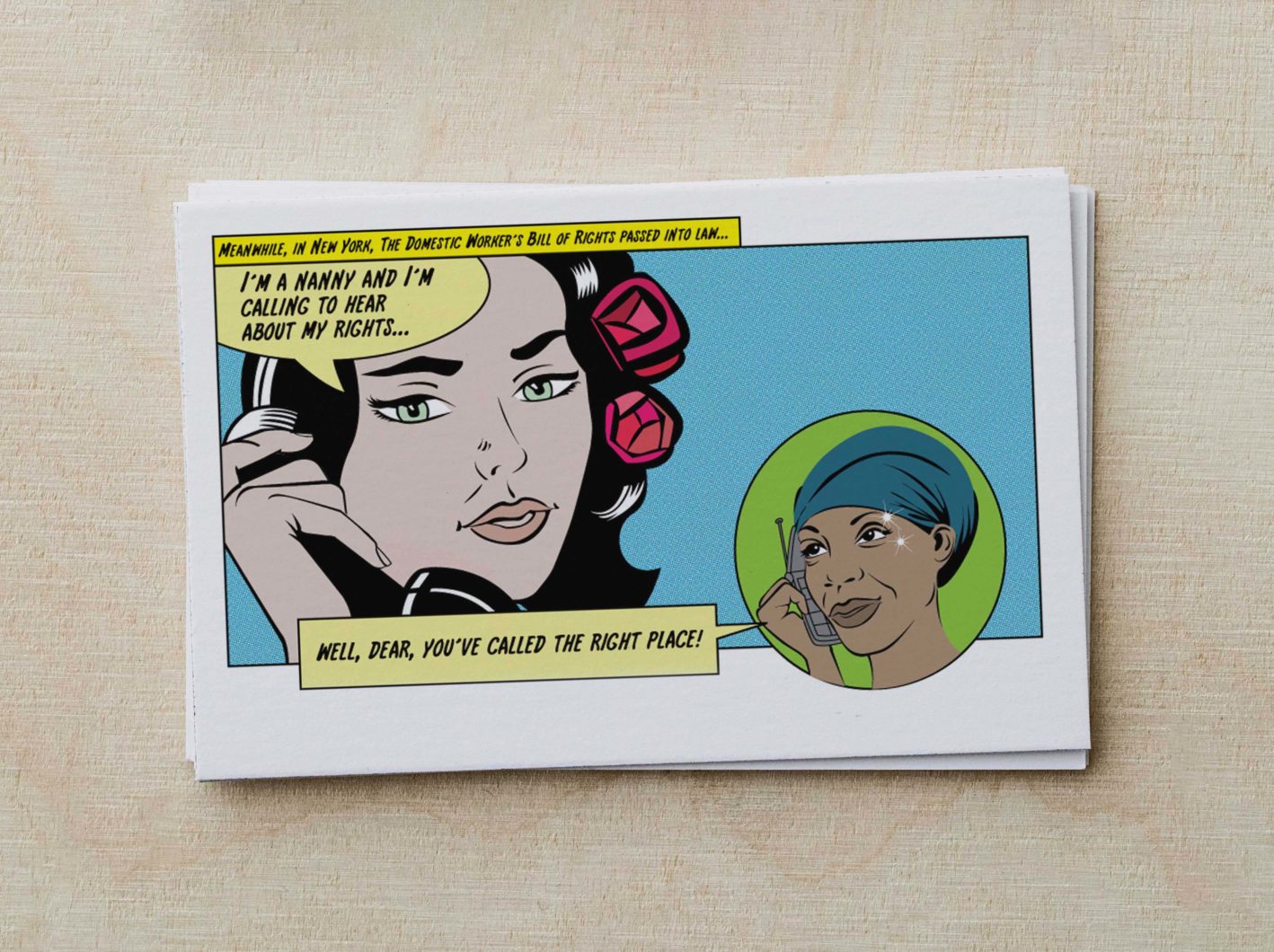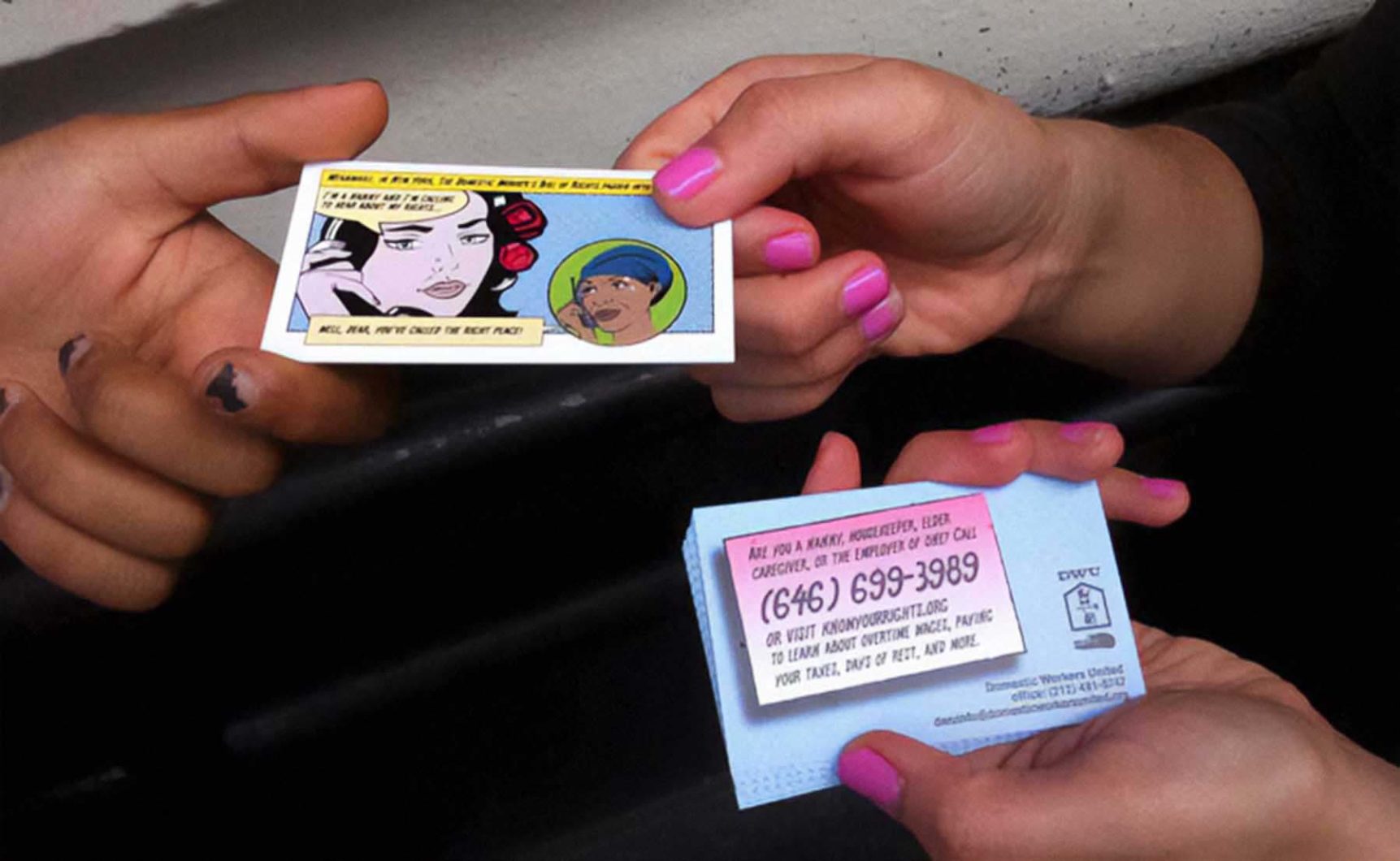New Day New Standard (now the “Domestic Worker App”)
A public art nanny hotline to inform domestic workers and caregivers about their rights



Initiator(s)
Studio REV
Description
The Domestic Worker App is a call-in service accessible from cell phones which informs domestic workers, caregivers and nannies about their rights related to overtime wages, taxes, vacations and so on. Information is given in the form of an ‘audionovela’ hosted by the voice of Christine Lewis, a nanny who explains domestic workers' rights, which draw from common employee-employer relationships. The more the app is used, the more it collects data to expand the research, becoming a tool for mutual education. The project has been used as an organisational tool by the Domestic Workers United, which distributes business cards featuring the hotline number in places where domestic workers usually gather. The project evolved in the CareForce, two mobile studios (the Nanny Van and the CareForce One) to reach domestic workers around the country through the distribution of toolkits and the organisation of informative events. One of the road trips from New York City to Miami has been documented through a film series, the CareForce Travelogues, exploring how care intersects with immigration, the legacy of slavery and racial discrimination. The project is currently developing in the Care Pod, an independent living unit for caregivers which would allow them to live in clusters beside the elderly.
Context
According to the National Domestic Worker Alliance (NDWA) over 2.5 million people in the USA work as nannies, house cleaners and care workers. The majority of domestic workers are either women with an immigration background or women of colour, who earn a median wage of $11.43 per hour without basic rights such as overtime pay, protections against sexual harassment, sick leave, meal and rest break, and so on. Care jobs are one of the fastest growing jobs in the next decade and it was accelerated by the Covid-19 pandemic in 2020. However, domestic workers are still the most vulnerable workers in the USA. When the state of New York became the first to pass a domestic worker bill of rights in 2010, Studio Rev partnered with the NDWA to create toolkits to inform and educate domestic workers about their rights.
How to use it
Domestic workers need a mobile phone to call the number to listen to the ‘audionovela’ which gives information about their labour rights.
Goals
The Domestic Worker App was designed to inform the 200,000+ nannies, housekeepers, and caregivers in New York State about the landmark 2010 Domestic Workers Bill of Rights. Now the project amplifies the voices of care workers throughout the production of toolkits to educate and inform domestic workers around the Nation.
Beneficial outcomes
Through informative campaigns in collaboration with the NDWA, the project created the context for bettering the working conditions for domestic workers.
The Domestic Worker App functions as a key component of a various states' campaigns that seek to encourage domestic workers and their employers to comply with the law.
Ai-jen Poo (2019), CareForce: Creating a Future with Care Workers as Protagonists, [online] Visible Project
Location
United States of America
Field
UIT (use it together), Usership, 1:1 Scale, Narratorship
Strategy
Legislative Change, Labor Rights, Immigration Rights
Users
Domestic care workers such as nannies, housekeepers, elder caregivers and their employees.
Maintained by
Initial supporters were Tribeca Film Festival, Rockefeller Foundation, Funding Exchange, North Star Fund, MIT Community Service Fund, MIT Council for the Arts, NuLawLab, individual donors. It is maintained by Sundance Institute, The Fledgling Fund, National Endowment for the Arts, NYSCA, MapFund, Asian Women Giving Circle, National Employment Law Project, Urban Justice Center, Mujeres Unidas y Activas, Philipino Worker Center, Adhikaar for Human Rights, Hand in Hand: Domestic Employer Association, Coalition for Human Immigrant Rights of Los Angeles, Instituto de Educación Popular del Sur de California, Terravoz, Arizona State University Art Museum, Queens Museum, Brooklyn Museum, Perez Art Museum Miami, Oakland Museum, Columbia College Chicago, 18th St. Arts, New York Arts Practicum
Duration
2011 - ongoing
Coefficient of Arte Util
80%
Category
Scientific
Pedagogical
Politics
Urban Development
Economy
Environment
Social






